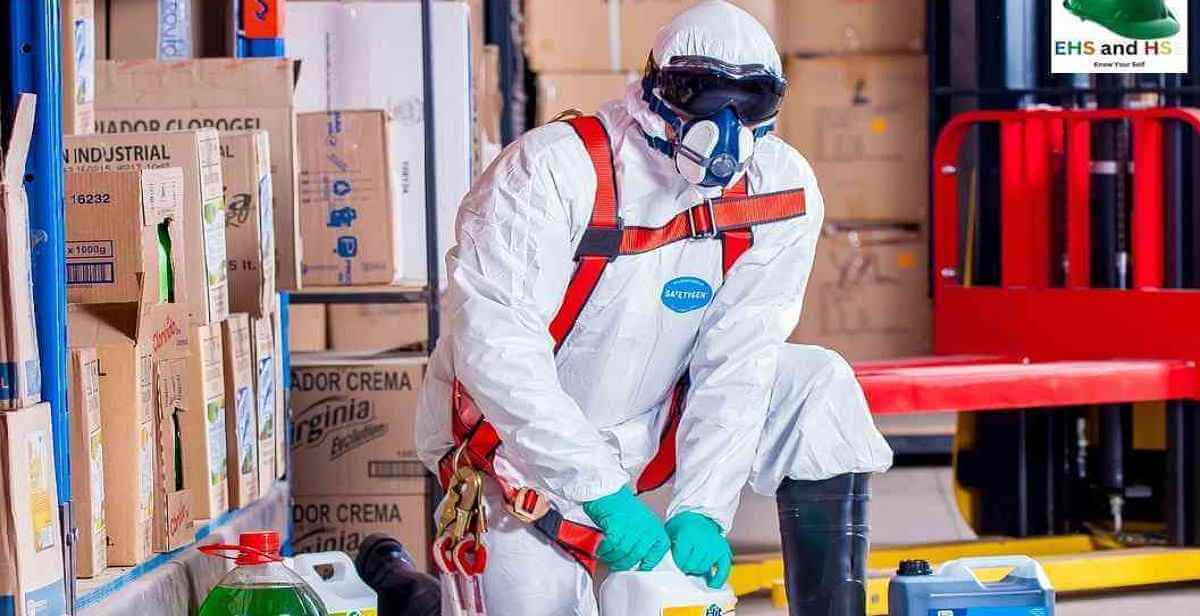1. Handling Chemicals Safely
- Handling chemicals safely will reduce the risks of accidents involving chemical hazards. Personnel supervisors of chemicals must be familiar with regulations on how to handle chemicals properly.
- The proper Personnel Protective Equipment (PPE) is needed for handling chemicals. Also in control of the chemical spills, such as gloves and masks, must always be available in a facility.
- Personnel should also be trained on how to use PPE during chemical handling.
- Safety Data Sheets (SDS) or Material Safety Data Sheets (MSDS) must be readily available for all chemicals on a work site/chemical area. Detail about Control of chemical spillage.
2. Protection of Chemical’s Victim.
- Before helping a victim make sure that you or anyone else will not be in danger.
- Wear appropriate PPEs before helping the victim of chemicals.
- If the victim has fallen into the chemical, he may have to be moved to a safe place before he can perform first aid.
- If appropriate PPE gear is not available. Then take limited risks about first aid for the victim. Call emergency services immediately and wait for them.
3. Check the victim’s Breathing
- Check the victim for a response before starting first aid and call for help.
- Open the victim’s mouth and check for blockages. Roll the victim onto the side to clear any blockages. Tilt the head back to open the airway.
- Listen: Place your ear near the victim’s face and listen to the breathing.
- Feel: feel the moving air on your cheek from the victim’s nose and mouth.
- See: Movement of victim’s chest.
- Place your hand on the victim’s stomach and check for movement, which indicates the victim’s breathing. If the victim is not breathing start doing (CPR) Cardiopulmonary Resuscitation and call for a defibrillator.
4. Decontamination of the Eyes.
When dealing with eye contamination the aim is to disperse and dilute the chemical to clear eye.
- Use an eyewash fresh water shower to clean eyes for 20 minutes.
- If the eye is shut then open it carefully. Hold the victim’s head so the waterfalls on the affected eye run water for 20 minutes.
- Check the eyewash expiry date and packaging seal. If in doubt of the quality, don’t use it.
- If no eyewash is available then check the Safety Data Sheets of chemical to see if water can be used instead.
- If water can be used then ensure the water, source, and container are clean.
- Call emergency services immediately.
- Make sure to wear gloves before first aid.
- Ask the victim person to hold a sterile dressing over the affected eye.
- Identify the chemical’s property involved and gather as much information about it as you can.
5. Decontamination of the Body.
- Remove contaminated clothing from the victim’s body. Use scissors for cutting, unless contaminated clothing is sticking to the victim’s skin.
- If the victim is conscious, assist him into the emergency shower.
- If the victim is unconscious, shower him on the spot.
- Use a hose or large water container and ensure clean water flows over the victim’s contaminated parts for 20 minutes.
- Ensure unaffected parts are safe from contaminated water.
6. Controlling Risks
- Proper chemical handling will reduce the risks of chemical hazards.
- Make a sheet about workplace risk assessment to ensure all practices are safe.
- Chemicals should be stored at a designated storage space, in the appropriate container.
- Chemical waste should be properly disposed of as hazardous waste.
- Proper transport should be provided for chemical transfer safely inside and outside the workplace.
- All personnel in the chemical workplace should be properly trained as floor warden on what to do in case of a chemical spill.
7. Following Up on an Accident
- Chemical spillage can cause other symptoms such as breathing problems.
- Only chemical antidotes are used if you are properly trained otherwise don’t use them.
- If possible, send chemical information to the hospital with the victim.
- Inform the responding personnel about the nature of the chemical so they can provide the right PPE.
- Report the accident to the EHS or safety officer.

